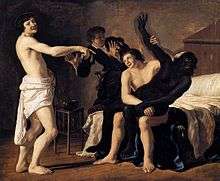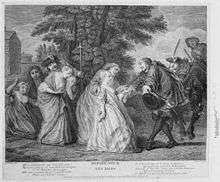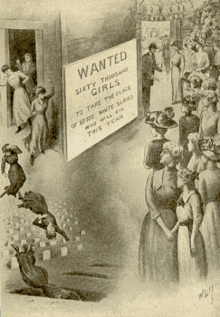History of sexual slavery in the United States
The history of sexual slavery in the United States is the history of slavery for the purpose of sexual exploitation as it exists in the United States.
African-American slaves were often raped or forced to breed with other slaves. Early American colonists were largely male, and some men resorted to force to procure wives. Native American women were often captured to be traded, sold, or taken as wives. Poor European women were forced to migrate against their will to the United States to be wives. At the beginning of the 19th century, there was growing concern over "white slavery", which referred to the kidnapping of females to work in the sex industry. A number of laws, such as the White-Slave Traffic Act of 1910, were passed making it illegal to transport women across state lines for moral purposes. The laws have continued to change, especially regarding the boundary between a willing prostitute and an innocent victim. Currently, under federal law, a prostitute is considered a victim of human trafficking if he or she is either under 18 or is being controlled through force, fraud or coercion. However, this is not fully implemented, and in many states, prostitutes who are considered victims under federal law are still arrested and prosecuted under state law.
Under chattel slavery

From the beginning of African slavery in the North American colonies, slaves were often viewed as property, rather than people. Slave women were often raped by white overseers, planter's younger sons before they married, and other white men associated with the slaveholders. Some were sold into brothels outright. Plaçage, a formalized system of concubinage among slave women or free people of color, developed in Louisiana and particularly New Orleans by the 18th century.
Slave breeding was the attempt by a slave-owner to influence the reproduction of his slaves for profit.[1] It included forced sexual relations between male and female slaves, encouraging slave pregnancies, sexual relations between master and slave to produce slave children and favoring female slaves who had many children.[2] The historian E. Franklin Frazier, in his book The Negro Family, stated that "there were masters who, without any regard for the preferences of their slaves, mated their human chattel as they did their stock." Ex-slave Maggie Stenhouse remarked, "Durin' slavery there were stockmen. They was weighed and tested. A man would rent the stockman and put him in a room with some young women he wanted to raise children from."[3]
Many female slaves (known as "fancy maids") were sold at auction into concubinage or prostitution, which was called the "fancy trade".[4] Concubine slaves were the only female slaves who commanded a higher price than skilled male slaves.[5]
In Louisiana

The plaçage system developed from the predominance of men among early colonial populations, who took women as consorts from Native Americans and enslaved Africans. In this period there was a shortage of European women, as the colonies were dominated in the early day by male explorers and colonists. Given the harsh conditions in Louisiana, persuading women to follow the men was not easy. France sent females convicted along with their debtor husbands, and in 1719, deported 209 women felons "who were of a character to be sent to the French settlement in Louisiana."[6] France also relocated young women orphans known as King's Daughters (French: filles du roi) to their colonies for marriage: to both Canada and Louisiana.
Through warfare and raids, Native American women were often captured to be traded, sold, or taken as wives. At first, the colony generally imported male Africans to use as slave labor because of the heavy work of clearing to develop plantations. Over time, it also imported African female slaves. Marriage between the races was forbidden according to the Code Noir of the eighteenth century, but interracial sex continued. The upper class European men during this period often did not marry until their late twenties or early thirties. Premarital sex with an intended white bride, especially if she was of high rank, was not permitted socially.
White male colonists, often the younger sons of noblemen, military men, and planters, who needed to accumulate some wealth before they could marry, took women of color as consorts before marriage. Merchants and administrators also followed this practice if they were wealthy enough. A white man might rape a slave as young as twelve.
Post-emancipation
After slaves were emancipated, many states passed anti-miscegenation laws, which prohibited interracial marriage between whites and non-whites. But this did not stop white men from taking sexual advantage of black women by using their social positions of power under the Jim Crow system and white supremacy, or in other parts of the country by ordinary power and wealth dynamics.
During the California Gold Rush in the late 1840s, Chinese merchants transported thousands of young Chinese girls, including babies, from China to the United States and sold them into sexual slavery within the red light district of San Francisco. Girls could be bought for as cheap as $40 (about $1104 in 2013 dollars) in Guangzhou, and sold for $400 (about $11,040 in 2013 dollars) in the United States. Many of these girls were forced into opium addiction and lived their entire lives as prostitutes.[7][8]
A few captives from Native American tribes who were used as slaves were not freed, when African-American slaves were emancipated. "Ute Woman," a Ute captured by the Arapaho and later sold to a Cheyenne, was one example. Used as a prostitute for sale to American soldiers at Cantonment in the Indian Territory, she lived in slavery until about 1880 when she died of a hemorrhage resulting from "excessive sexual intercourse".[9]
White slavery

By the 19th century, most of America's cities had a designated, legally protected area of prostitution. Increased urbanization and young women entering the workforce led to greater flexibility in courtship without supervision. It is in this changing social sphere that the panic over "white slavery" began. This term referred to women being kidnapped for the purposes of prostitution.
Numerous communities appointed vice commissions to investigate the extent of local prostitution, whether prostitutes participated in it willingly or were forced into it and the degree to which it was organized by any cartel-type organizations. The second significant action at the local levels was to close the brothels and the red light districts. From 1910 to 1913, city after city withdrew this tolerance and forced the closing of their brothels. Opposition to openly practiced prostitution had been growing steadily throughout the last decades of the 19th century. The federal government's response to the moral panic was the Mann Act. The purpose of the act was to make it a crime to coerce transportation of unwilling women. The statute made it a crime to "transport or cause to be transported, or aid to assist in obtaining transportation for" or to "persuade, induce, entice or coerce" a woman to travel.[10]

According to historian Mark Thomas Connelly, "a group of books and pamphlets appeared announcing a startling claim: a pervasive and depraved conspiracy was at large in the land, brutally trapping and seducing American girls into lives of enforced prostitution, or 'white slavery.' These white slave narratives, or white-slave tracts, began to circulate around 1909."[11] Such narratives often portrayed innocent girls "victimized by a huge, secret and powerful conspiracy controlled by foreigners", as they were drugged or imprisoned and forced into prostitution.[11]
This excerpt from The War on the White Slave Trade was written by the United States District Attorney in Chicago:
One thing should be made very clear to the girl who comes up to the city, and that is that the ordinary ice cream parlor is very likely to be a spider's web for her entanglement. This is perhaps especially true of those ice cream saloons and fruit stores kept by foreigners. Scores of cases are on record where young girls have taken their first step towards "white slavery" in places of this character.[11]
Suffrage activists, especially Harriet Burton Laidlaw[12] and Rose Livingston, worked in New York City's Chinatown and in other cities to rescue young white and Chinese girls from forced prostitution, and helped pass the Mann Act to make interstate sex trafficking a federal crime.[10] Livingston publicly discussed her past as a prostitute and claimed to have been abducted and developed a drug problem as a sex slave in a Chinese man's home, narrowly escaped and experienced a Christian conversion narrative.[13][14] Other groups like the Woman's Christian Temperance Union and Hull House focused on children of prostitutes and poverty in community life while trying to pass protective legislation. The American Purity Alliance also supported the Mann Act.[15]

In 1910, the US Congress passed the White Slave Traffic Act of 1910 (better known as the Mann Act), which made it a felony to transport women across state borders for the purpose of "prostitution or debauchery, or for any other immoral purpose". Its primary stated intent was to address prostitution, immorality, and human trafficking particularly where it was trafficking for the purposes of prostitution, but the ambiguity of "immoral purpose" effectively criminalized interracial marriage and banned single women from crossing state borders for morally wrong acts. As more women were being trafficked from foreign countries, the US began passing immigration acts to curtail aliens from entering the country. Several acts such as the Emergency Quota Act of 1921 and Immigration Act of 1924 were passed to prevent emigrants from Europe and Asia from entering the United States. Following the banning of immigrants during the 1920s, human trafficking was not considered a major issue until the 1990s.[16][17]
The 1921 Convention set new goals for international efforts to stem human trafficking, primarily by giving the anti-trafficking movement further official recognition, as well as a bureaucratic apparatus to research and fight the problem. The Advisory Committee on the Traffic of Women and Children was a permanent advisory committee of the League. Its members were nine countries, and several non-governmental organizations. An important development was the implementation of a system of annual reports of member countries. Member countries formed their own centralized offices to track and report on trafficking of women and children.[10] The advisory committee also worked to expand its research and intervention program beyond the United States and Europe. In 1929, a need to expand into the Near East (Asia Minor), the Middle East and Asia was acknowledged. An international conference of central authorities in Asia was planned for 1937, but no further action was taken during the late 1930s.[18]
Sex trafficking
Act 18 U.S.C. § 1591, or the Commercial Sex Act, the US makes it illegal to recruit, entice, obtain, provide, move or harbor a person or to benefit from such activities knowing that the person will be caused to engage in commercial sex acts where the person is under 18 or where force, fraud or coercion exists.[19][20]
Under the Bush Administration, fighting sex slavery worldwide and domestically became a priority with an average of $100 million spent per year, which substantially outnumbers the amount spent by other countries. Before President Bush took office, Congress passed the Victims of Trafficking and Violence Protection Act of 2000 (TVPA). The TVPA strengthened services to victims of violence, law enforcements ability to reduce violence against women and children, and education against human trafficking. Also specified in the TVPA was a mandate to collect funds for the treatment of sex trafficking victims that provided them with shelter, food, education, and financial grants. Internationally, the TVPA set standards that governments of other countries must follow in order to receive aid from the U.S. to fight human trafficking. Once George W. Bush took office in 2001, restricting sex trafficking became one of his primary humanitarian efforts. The Attorney General under President Bush, John Ashcroft, strongly enforced the TVPA. The Act was subsequently renewed in 2004, 2006, and 2008. It established two stipulations an applicant has to meet in order to receive the benefits of a T-Visa. First, a trafficked victim must prove/admit to being trafficked and second must submit to prosecution of his or her trafficker. In 2011, Congress failed to re-authorize the Act. The State Department publishes an annual Trafficking in Persons Report, which examines the progress that the U.S. and other countries have made in destroying human trafficking businesses, arresting the kingpins, and rescuing the victims.[21][22][23]
References
- ↑ Marable, Manning, How capitalism underdeveloped Black America: problems in race, political economy, and society South End Press, 2000, p 72
- ↑ Marable, ibid, p 72
- ↑ Work Projects Administration, Slave Narratives: A Folk History of Slavery in the United States from Interviews with Former Slaves, Arkansas Narratives, Part 6, Kessinger Publishing, 2004, p. 154.
- ↑ Moon, p 235
- ↑ Baptist, Edward E. "'Cuffy', 'Fancy Maids', and 'One-Eyed Men': Rape Commodification, and the Domestic Slave Trade in the United States", in The Chattel Principle: Internal Slave Trades in the Americas, Walter Johnson (Ed.), Yale University Press, 2004
- ↑ Katy F. Morlas, "La Madame et la Mademoiselle," graduate thesis in history, Louisiana State University and Agricultural and Mechanical College, 2003
- ↑ Albert S. Evans (1873). "Chapter 12". A la California. Sketch of Life in the Golden State. San Francisco: A.L. Bancroft and Company.
- ↑ Unusual Historicals: Tragic Tales: Chinese Slave Girls of the Barbary Coast. Unusualhistoricals.blogspot.com (25 August 2010). Retrieved on 2015-10-29.
- ↑ Berthrong, Donald J. (1976). The Cheyenne and Arapaho Ordeal: Reservation and Agency Life in the Indian Territory, 1875 to 1907. University of Oklahoma Press. p. 124. ISBN 0-8061-1277-8.
- 1 2 3 Brian K. Landsberg. Major Acts of Congress. Macmillan Reference USA: The Gale Group, 2004. 251-253. Print
- 1 2 3 Bell, Ernest Albert. The War on the White Slave Trade. Chicago: GS Ball, 1910. eBook.
- ↑ Laidlaw, H. B. (Harriet Burton), b. 1874, Papers, 1851–1958, A Finding Aid, harvard.edu
- ↑ Lui, Mary Ting Yi (1 September 2009). "Saving young girls from Chinatown: white slavery and woman suffrage, 1910-1920". Journal of the History of Sexuality.
- ↑ Massotta, Jodie. Decades of Reform: Prostitutes, Feminists, and the War on White Slavery. Diss. University of Vermont, 2013. Print.
- ↑ Bell, pp. 44-45.
- ↑ Candidate, Jo Doezema Ph.D. "Loose women or lost women? The re-emergence of the myth of white slavery in contemporary discourses of trafficking in women." Gender issues 18.1 (1999): 23-50.
- ↑ Donovan, Brian. White slave crusades: race, gender, and anti-vice activism, 1887-1917. Urbana and Chicago: University of Illinois Press, 2006.
- ↑ Elizabeth Faue. The Emergence of Modern America(1990 to 1923). Encyclopedia of American History, 2003. pp. 169-170. Print
- ↑ "Stop Sex Trafficking.". Retrieved 2010-03-10.
- ↑ "Victims Of Trafficking And Violence Protection Act of 2000." (PDF).
- ↑ Soderlund, Gretchen. "Running from the rescuers: new US crusades against sex trafficking and the rhetoric of abolition." nwsa Journal 17.3 (2005): 64-87.
- ↑ Feingold, David A. "Human trafficking." Foreign Policy (2005): 26-32.
- ↑ Horning, A., Thomas, C., Henninger, A. M., & Marcus, A. (2014). The Trafficking in Persons Report: a game of risk. International Journal of Comparative and Applied Criminal Justice, 38(3).
